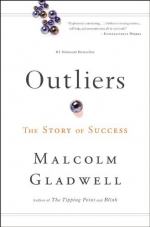
|
| Name: _________________________ | Period: ___________________ |
This test consists of 15 multiple choice questions and 5 short answer questions.
Multiple Choice Questions
1. Why does Flom and those of his generation have their pick of good schools?
(a) College is not valued at that time.
(b) The supply of students is relatively low.
(c) College is just becoming popular and so colleges are competing to get students.
(d) New universities are arising rapidly in this era.
2. Who utters an audible insult to some of the men in the experiment?
(a) One of the audience members.
(b) A man partially blocking the hallway.
(c) No one.
(d) One of the psychologists interviewing the men.
3. Where is the burden of understanding placed in a conversation between two Koreans?
(a) It depends on the relative social status of the two who are interacting.
(b) Equally between the listener and speaker.
(c) The listener.
(d) The speaker.
4. What does Gladwell say Asian cultures value?
(a) Diversity.
(b) Finding one's own niche in society.
(c) Honor.
(d) Hard work.
5. Why does the pilot have difficulty seeing the runway?
(a) The electricity is off.
(b) Heavy rain.
(c) Heavy fog.
(d) Heavy smoke.
6. What does Korean Airlines perform?
(a) A extensive retrofit of their planes.
(b) An internal audit.
(c) An upgrade to their planes.
(d) Fire all of the employees.
7. What do the men have to do after performing the task asked of them?
(a) Walk down a hall to hand it in.
(b) Undergo a battery of psychological tests.
(c) Write up their impressions of the experience.
(d) Share their experience with an audience.
8. What does George Hofstede research?
(a) Cultural differences within a country.
(b) Training routines.
(c) Cultural differences among countries.
(d) Plane crashes.
9. What do many of the children of the Borgenichts family and those like them become?
(a) Doctors and lawyers.
(b) Businessmen.
(c) Artists in various areas.
(d) Teachers.
10. What do some countries consider doing with Korean Airlines?
(a) Banning it from landing in their countries.
(b) Encourage it to operate in their country.
(c) Helping it overcome its safety problems.
(d) Suing it.
11. What is Joe Flom's occupation?
(a) Lawyer.
(b) CEO of a trade corporation.
(c) CEO of a technological corporation.
(d) Doctor.
12. What do the ask some college-aged men to do?
(a) Refrain from talking to any woman for 72 hours.
(b) Fill out a questionaire.
(c) Sit in a room alone for 24 hours.
(d) Fast for 24 hours.
13. Where does Joe Flom grow up?
(a) Brooklyn.
(b) Miami.
(c) Newark.
(d) Washington, D. C.
14. From what are of the world are the highest-scoring students in the field of math?
(a) North America.
(b) Asia.
(c) South America.
(d) Europe.
15. What type of parenting style seems to be beneficial to the education of children?
(a) The ones who allow the children to choose what they want to do over the summer.
(b) The parents who are so busy, the children have to read to fill their time.
(c) Those who engage their children and offer them opportunities continue to learn and improve over the summer.
(d) The parents who force their children to work for pay over the summer.
Short Answer Questions
1. Why do Flom and his colleagues take on proxy wars?
2. From what region of the country are the angriest subjects?
3. What grade level is the school?
4. Where do Cohen and Nisbett conduct an experiment?
5. Who are the Howards and Turners?
|
This section contains 581 words (approx. 2 pages at 300 words per page) |

|




